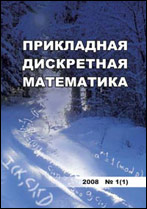|
This article is cited in 3 scientific papers (total in 3 papers)
Mathematical Foundations of Intelligent Systems
Constructing an aggregated relation with a minimum distance from the expert preferences
V. N. Nefedov, S. O. Smerchinskaya, N. P. Yashina
Moscow Aviation Institute, Moscow, Russia
Abstract:
The paper considers the problem of collective choice. Profile of experts' individual preferences on the set of alternatives can be given by binary relations or numerical evaluations of alternatives. Methods for constructing preferences matrices for various types of expert information are proposed, as well as methods for forming an aggregated relation that satisfies the condition of minimizing the total distance to expert preferences.
Let expert preferences in the form of binary relations $\rho_1,\rho_2,\ldots ,\rho_m$ are given by the vertex adjacency matrices $R^1,R^2,\ldots ,R^m$ of the corresponding digraphs. The distance between the relations is defined as the Hamming distance. We prove that the aggregate relation,which is built according to the rule of “the majority of experts”, satisfies the condition of minimum distance from expert preferences.
In the case, when the profile of expert preferences is given by relations of a strict order and the number of experts is odd, the aggregated relation is unique.
Let the estimates of the alternatives $a_1,a_2,\ldots ,a_n$ by the $t$-th expert be given in the form of a vector $h^t=\langle h_1^t,h_2^t,\ldots ,h_n^t\rangle$ with positive real components. Then the elements of the preference matrix $R^t=\|r_{ij}^t\|$ have the form $r_{ij}^t=\dfrac{h_i^t}{h_i^t+h_j^t}$, if the values of estimates on the scale are maximized. We prove that the aggregated preference relation depends on the choice of the formula for determining the distance between the preferences matrices. When you specify the distance through the module of the difference of the preference matrices elements, then the total distance is minimal if all the elements of the aggregated matrix are equal to the medians of the corresponding elements of expert matrices. When you specify the distance through the square of the elements difference, then the distance is minimal if all the elements of the aggregated matrix are equal to the arithmetic means of the corresponding elements of expert matrices.
The developed technique can be used to solve multi-criteria problems in the assessment of alternatives in the scales of relations.
Keywords:
collective choice, aggregate relation, profile of experts' individual preferences, minimum distance from preferences, majority graph.
Citation:
V. N. Nefedov, S. O. Smerchinskaya, N. P. Yashina, “Constructing an aggregated relation with a minimum distance from the expert preferences”, Prikl. Diskr. Mat., 2018, no. 42, 120–132
Linking options:
https://www.mathnet.ru/eng/pdm647 https://www.mathnet.ru/eng/pdm/y2018/i4/p120
|

| Statistics & downloads: |
| Abstract page: | 178 | | Full-text PDF : | 91 | | References: | 29 |
|




 Contact us:
Contact us: Terms of Use
Terms of Use
 Registration to the website
Registration to the website Logotypes
Logotypes







 Citation in format
Citation in format 
